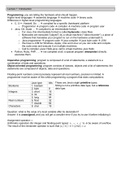Samenvatting
Summary Object-oriented Programming CSE1100
- Instelling
- Technische Universiteit Delft (TU Delft)
A summary of the course Object-oriented Programming (CSE1100) of TU Delft, part of the bachelor Computer Science and Engineering.
[Meer zien]




